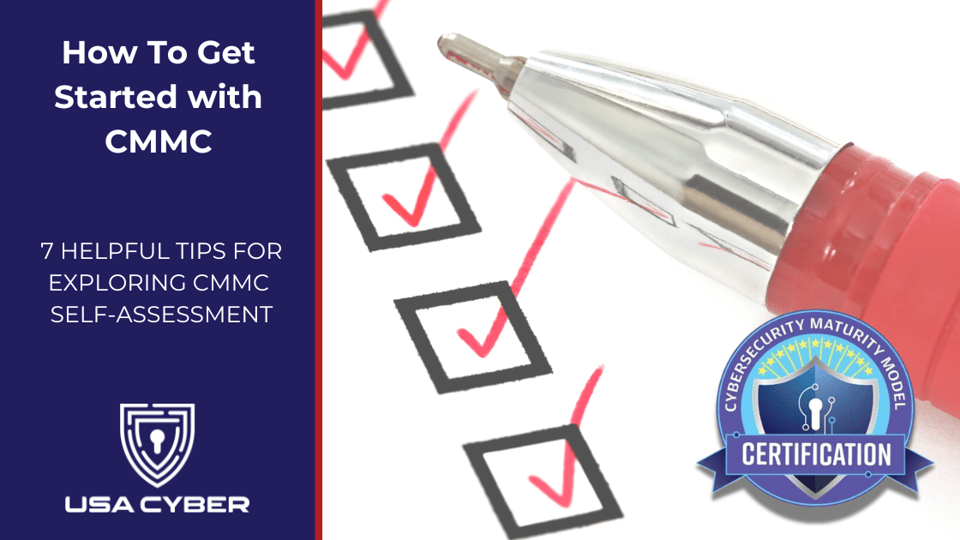
Preparing for CMMC certification can feel overwhelming, but the right approach makes the process manageable. These 7 essential self-assessment tips help businesses identify compliance gaps, strengthen security, and prepare for a smooth certification process.
What You'll Learn:
- How to evaluate your current cybersecurity posture
- Steps to ensure your organization is ready for CMMC certification
- When to seek expert guidance for compliance support
Why Start with a CMMC Self-Assessment?
Before pursuing CMMC certification, businesses should evaluate their current security posture. A self-assessment helps identify gaps in compliance, allowing organizations to correct deficiencies before an official audit.
Even companies requiring third-party assessments (C3PAO audits) can benefit from internal evaluations to ensure readiness. Below are 7 key self-assessment tips to help your business prepare effectively.
7 CMMC Self Assessment Tips
Tip #1: Identifying Your Required CMMC Level
Before assessing compliance, determine which CMMC level applies to your business:
| CMMC Level 1 | For organizations handling Federal Contract Information (FCI), requiring basic security measures. |
| CMMC Level 2 | For businesses handling Controlled Unclassified Information (CUI), requiring 110 security controls aligned with NIST SP 800-171. |
| CMMC Level 3 | For organizations working with highly sensitive defense data, requiring DoD-led assessments. |
Understanding your required level ensures your self-assessment focuses on the correct security requirements.
Tip #2: Review CMMC’s Core Security Controls
CMMC compliance is based on core security principles, such as:
- Access Controls: Restricting user access based on roles and permissions.
- Incident Response Plans: Having a clear process for handling security incidents.
- Data Encryption: Ensuring all CUI and sensitive data is encrypted.
Compare your current cybersecurity policies against these controls to identify areas that need improvement.
Tip #3: Conduct a Security Gap Analysis
A security gap analysis helps businesses identify compliance weaknesses by comparing current security practices with CMMC requirements.
Step 1: List all current security policies and procedures.Step 2: Compare them against the CMMC control requirements for your level.
Step 3: Document any missing security controls that need improvement.
A thorough gap analysis prevents last-minute surprises during certification. Working with a cybersecurity expert that specializes in CMMC compliance is recommended to ensure your gap assessment is as thorough as an official assessment.
Tip #4: Strengthen Employee Cybersecurity Training
Many CMMC requirements focus on employee awareness and training. Businesses should:
- Implement annual security awareness training for all employees.
- Educate staff on phishing risks, password management, and access control.
- Ensure employees understand how to handle Controlled Unclassified Information (CUI) properly.
Cybersecurity training reduces human error, which is one of the biggest risks in CMMC compliance.
Tip #5: Document Your Compliance Efforts
CMMC certification requires detailed documentation of security policies. Businesses should maintain:
- System Security Plan (SSP) – Outlining cybersecurity policies and procedures.
- Plan of Action & Milestones (POA&M) – Documenting any gaps and planned fixes.
- Incident Response Plan (IRP) – Defining response steps for cybersecurity incidents.
Proper documentation not only improves compliance readiness but also helps businesses stay organized for audits.
Tip #6: Test Your Cybersecurity Defenses
Performing internal security tests helps validate whether existing controls are effective.
- Run simulated phishing attacks to evaluate employee awareness.
- Conduct penetration testing to uncover security vulnerabilities.
- Review access control logs for any unauthorized system access attempts.
Testing security controls helps identify weaknesses before an official CMMC audit.
Tip #7: Determine If You Need External Compliance Support
While some businesses can manage CMMC compliance internally, others may benefit from expert guidance. Consider hiring:
- A CMMC consultant to conduct a pre-audit readiness assessment.
- A Managed Security Service Provider (MSSP) to help implement required security controls.
- A Certified Third-Party Assessor (C3PAO) if your business requires a formal audit.
Seeking external compliance support can prevent costly mistakes and speed up the certification process.
Need Expert Guidance on CMMC?
The experts at USA Cyber are here to help.
Our expert CMMC advisory team is here to help guide you through the path to CMMC compliance certification.
In Summary: How to Get Started with CMMC Compliance
A self-assessment is the first step toward successful CMMC certification. By reviewing security controls, identifying compliance gaps, and strengthening cybersecurity policies, businesses can avoid last-minute surprises and reduce audit risks.
Key Takeaways:
- Know your required CMMC level before starting compliance efforts.
- Conduct a security gap analysis to identify compliance weaknesses.
- Employee training and security documentation are critical to passing audits.
- Testing security controls and seeking expert guidance can improve compliance readiness.
